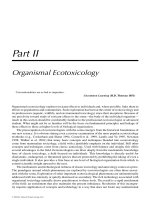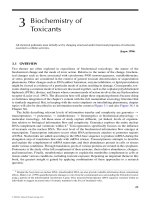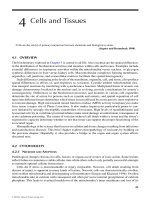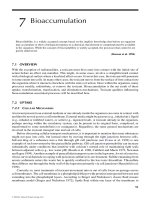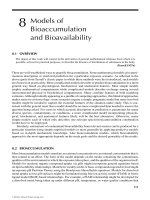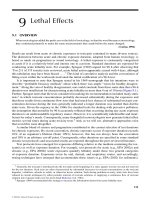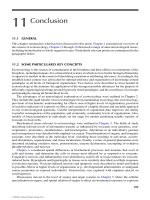ECOTOXICOLOGY: A Comprehensive Treatment - Chapter 11 docx
Bạn đang xem bản rút gọn của tài liệu. Xem và tải ngay bản đầy đủ của tài liệu tại đây (103.33 KB, 3 trang )
Clements: “3357_c011” — 2007/11/9 — 12:42 — page 189 — #1
11
Conclusion
11.1 GENERAL
This chapter summarizes what has been discussed to this point. Chapter 1 presented an overview of
the science of ecotoxicology. Chapters 2 through 10 discussed a range of autecotoxicological issues,
including biomolecular to whole organism issues. Particularly relevant points are summarized in the
paragraphs below.
11.2 SOME PARTICULARLY KEY CONCEPTS
Ecotoxicology is the science of contaminants in the biosphere and their effects on constituents of the
biosphere, including humans. It is a hierarchical science in which no level in the biological hierarchy
is superior to another in the context of identifying causation or attributing relevance. Accordingly, the
modified Janus context was advocated for optimal inference and organization of knowledge around
paradigms at all levels of biological organization. Two factors were described as most needed in
ecotoxicology at the moment: the application of the strongest possible inferences for the purpose of
efficiently organizing knowledge aroundrigorouslytestedparadigms, and the consilience of concepts
and paradigms among all hierarchical levels.
The advantages of an autecological exploration of ecotoxicology were outlined in Chapter 2.
They include the rapid transfer of new technologies from mammalian toxicology into ecotoxicology,
provision of mechanistic understanding for effects seen at higher levels of organization, provision
of sensitive indicators of exposure or effect, and creation of a highly discrete and tractable approach
to any ecotoxicological questions. Careful interpretation of organismal data improves our ability
to predict consequences at the population, and commonly, community levels of organization. Also,
models of bioaccumulation in individuals set the stage for models predicting trophic transfer of
toxicants in food webs.
Biochemical issues relevant to ecotoxicology were outlined in Chapter 3. The fields of study
describing relevant levels of information transfer as influenced by toxicants were genomics, tran-
scriptomics, proteomics, metabolomics, and bioenergetics. Alterations to an individual’s genome
and consequences were detailed with emphasis on cancer. Transformations of organic and inorganic
toxicants were described at the molecular level, including those resulting in activation, acceler-
ated elimination, sequestration, and tissue localization. Finally, a series of general phenomena were
described including oxidative stress, proteotoxicity, enzyme dysfunction, uncoupling of oxidative
phosphorylation, and narcosis.
Chapter 4 considered spatial differences in biochemical processes and moieties that exist in
cells and tissues, and determine the cells or tissues most affected by or responsive to toxicants.
Coagulative necrosis and inflammation were identified as useful cell or tissue markers for toxicant-
induced harm. Hyperplasia and hypertrophy in tissues were similarly described as telltale responses
to toxicant exposure. Toxicant-induced necrosis and apoptosis were described in detail and linked
to possible effects at higher levels of organization (e.g., developmental abnormalities or malignant
cancer promotion in exposed individuals). Genotoxicity was explored with emphasis placed on
carcinogenesis.
Discussions moved to the level of organs and organ systems in Chapter 5 where the cellular
specialization in organs, and spatial relation of organs to direct environmental exposure or exposure
189
© 2008 by Taylor & Francis Group, LLC
Clements: “3357_c011” — 2007/11/9 — 12:42 — page 190 — #2
190 Ecotoxicology: A Comprehensive Treatment
via somatic circulation were described as critical to making some organs more prone to poisoning
than others. Qualities influencing entry into, effects within, and potential transformations of toxicants
were described for the integument, respiratory organs, liver and analogous organs, digestive organs,
and excretory organs. Similar discussions were developed for the immune, circulatory, nervous
and endocrine systems, and the associated effects were related to consequences at higher levels of
organization.
Chapter 6 was a relatively short one in which selected physiological issues not addressed suf-
ficiently elsewhere were discussed. A strong theme was the impact of toxicants on the optimal
movement of materials and energy between the organism and its environment (i.e., Darwinian
fitness). Accordingly, most changes were also discussed in the contexts of life history shifts
or trade-offs with toxicant exposure. Homeostasis-related issues included pH, ion, and osmotic
regulation.
The emphasis shifted in Chapter 7 to accumulation of toxicants in individuals. Cellular and para-
cellular movements were described for different classes of toxicants including highly lipid-soluble
organic, ionizable organic, and ionic inorganic toxicants. Discussion began at the cellular level
and moved to the organismal level in discussions of movement associated with ingestion, res-
piration, and dermal routes. General principles surrounding toxicant movement into and out of
cells were presented first. Next, such principles were outlined for the ingestion, respiration, and
dermal routes. Applicable theory included the lipid solubility theory for nonionic organic com-
pounds; pH Partition Theory for weakly ionizable compounds; and the ionic hypothesis, free ion
activity model, biological ligand model, Hard Soft Acid Base (HSAB) theory, and quantitative ion
character–activity relationships for metals. The bioaccumulation and bioavailability themes con-
tinued into Chapter 8, which provided a quantitative treatment of related issues. Rate constant-,
clearance-, and fugacity-based formulations of bioaccumulation models were presented after gen-
eral discussion of issues such as reaction order. These formulations were extended to the PBPK
context. Noncompartment statistical moments methods were illustrated and used to explore issues
of bioavailability.
By Chapters 9 and 10, enough information had been explored so that discussion could turn to
lethal and sublethal effects on individuals. How ecotoxicologists treat lethal and sublethal effects
is strongly influenced by regulatory history and perceived needs. Lethal effects were characterized
as acute or chronic, but the reader was reminded that the distinction is blurry. The reader was also
shown that the dynamics by which lethality manifests differs among modes of action, exposure
route, and species. The often overlooked issue of diseases of adaptation was discussed including
shifts in syntoxic and catatoxic hormones. The foundation and various forms of toxicity curves
were explored, suggesting the need for more research in this area. Mixture effects were discussed
and quantified on the basis of mode of action. The survival time approach was discussed as an
alternative to conventional methods for quantifying lethal effects. The influences of previously
discussed molecular and ionic qualities were addressed again in the context of quantitative models of
lethality.
Sublethal effects discussed in Chapter 10 were framed initially in the context of Darwinian fitness
and then in the context of regulatory methods for their quantification. Sublethal stressor effects that
dominate the literature are those to growth and development, reproduction, physiology, and behavior.
Although most studies of sublethal effects apply rudimentary conceptual and experimental designs
that do not take full advantage of available ecological models, there is a clear movement away
from this condition. Sublethal effect metrics are currently estimated using either hypothesis testing
or point estimation approaches. Bioequivalence testing, a promising approach that avoids many of
the shortcomings of the conventional hypothesis tests, was discussed briefly as an underexploited
approach to assessing sublethal effects studies.
© 2008 by Taylor & Francis Group, LLC
Clements: “3357_c011” — 2007/11/9 — 12:42 — page 191 — #3
Conclusion 191
11.3 CONCLUDING REMARKS
In the next section, population ecotoxicology will be discussed in detail. This theme has characterist-
ics of both autecology and synecology. Consequently, the associated materials provide many exciting
concepts and techniques with the blending of organismal ecotoxicology and the ecotoxicology of
communities and ecosystem.
© 2008 by Taylor & Francis Group, LLC

